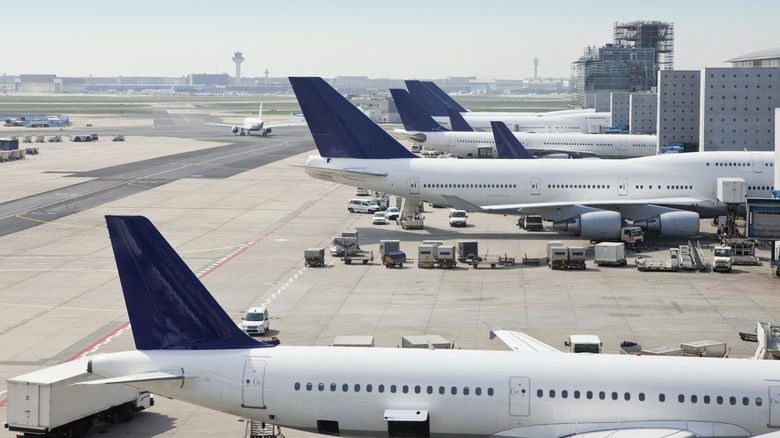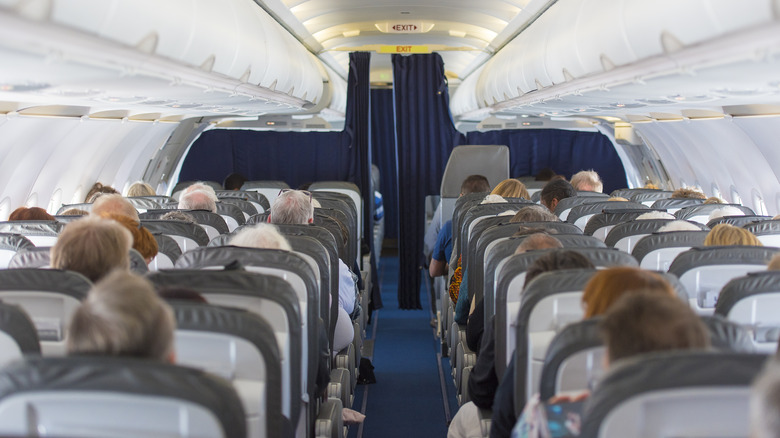Here's What A 'Ground Stop' At An Airport Means For Passengers, According To A Pilot
Airplanes are nothing short of engineering magic — giant flying machines that whisk us virtually anywhere in the world. But even the most seasoned jet-setters probably don't know all the quirks of these airborne vessels, like why those tiny window holes exist or why airplane cabins are almost always chilly. Sure, we know when a plane takes off or lands, but there's a lot more going on behind the scenes, too. Planes sometimes land at the wrong airport (it's not as uncommon as you think), or worse, they can get stuck on the ground — or in the air — for ages. This situation, known as a "ground stop," can throw a wrench in the travel plans of passengers on board.
In an exclusive interview with Islands, commercial airline pilot and aviation content creator Gary Baumgardner explained that ground stops are always implemented with safety in mind and are not just decided upon arbitrarily. "A ground stop is an air traffic control measure that temporarily halts all flights from taking off at one or more airports," he told us. "Ground stops are implemented for various reasons, including severe weather conditions, equipment malfunctions, runway closures, or other safety concerns that make it unsafe or inefficient for aircraft to continue operations as normal. They can also be used when there's an unexpected surge in air traffic, or if there are capacity issues at a specific airport."
In other words, when planes can't take off or land, it's not just because someone feels like playing traffic cop. While it can be a huge headache for passengers, at least it's all being done in the name of safety — or, sometimes, to keep airports from being more chaotic than they already are.
Ground stops are done for safety — but may inconvenience passengers
While ground stops are meant to ensure everyone's safety, they do end up being a major headache for passengers, especially those trying to catch a connecting flight or who are rushing to their destination for any number of reasons. "Ground stops can significantly impact both flights and passengers. Flights that haven't taken off yet are held on the ground, which leads to delays in departure times. This can create a cascading effect, causing further delays and disruptions throughout the day," Gary Baumgardner exclusively told Islands. "For passengers, this can mean missed connections, longer travel times, and general frustration due to the lack of clear information or updates on when their flight might depart."
Things get even more stressful when the ground stop happens mid-flight. In that case, the pilot literally has to continue flying the plane until they get the green light to land, which can be a nightmare for anyone with flight anxiety or a weak stomach. "Flights already in the air heading to an airport with a ground stop may be placed in a holding pattern, where the aircraft circles in a designated area until it's safe to proceed to the airport," Baumgardner told us, adding that there's also the chance that your flight could be redirected to a completely different airport, which creates a new set of problems. "If the ground stop is expected to last a long time, flights may be diverted to alternative airports. This adds additional fuel consumption, potential refueling stops, and further delays, affecting passengers' arrival times and potentially leading to a reshuffling of their travel plans."
Having a game plan is key
By now, we all know that travel is unpredictable, and there's no crystal ball to tell you if your flight will be delayed or hit with a ground stop right before take off. According to Gary Baumgardner, having a backup plan —or at least some extra patience — will serve you well because, again, ground stops are all about keeping air travel safe. Though it may not seem like it sometimes, the staff are doing everything they can to get you where you need to be, even if it feels like the universe just isn't syncing up with your schedule. You'd be surprised to know that it happens quite often, too. In June 2024, flights into Phoenix Sky Harbor Airport (PHX) were halted due to thick haze, and just a month later, over 3,000 domestic flights were grounded due to technical glitches that affected not just airlines but other businesses and government agencies as well.
"It's important for passengers to stay informed and patient during ground stops. Airlines and air traffic control work closely to manage these situations and resume normal operations as soon as it is safe to do so," Baumgardner shared with Islands. "While they can be inconvenient, ground stops are essential for maintaining the safety and efficiency of air travel."
That said, knowing your options if your flight gets delayed or canceled due to a ground stop is crucial. Don't forget to check out your refund options for canceled or delayed flights or, better yet, invest in travel insurance to cover your bases. Facing a travel disruption without any compensation is the final blow in an already frustrating situation.


